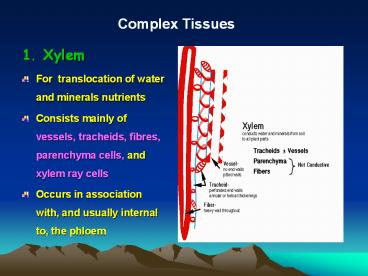1. Xylem - PowerPoint PPT Presentation
1 / 20
Title:
1. Xylem
Description:
Complex Tissues 1. Xylem For translocation of water and minerals nutrients Consists mainly of vessels, tracheids, fibres, parenchyma cells, and xylem ray cells – PowerPoint PPT presentation
Number of Views:95
Avg rating:3.0/5.0
Title: 1. Xylem
1
Complex Tissues
- 1. Xylem
- For translocation of water and minerals
nutrients - Consists mainly of vessels, tracheids, fibres,
parenchyma cells, and xylem ray cells - Occurs in association with, and usually internal
to, the phloem
2
A vascular bundle
3
sclerenchyma cells (fibers)
pit
end walls of vessel elements
pit
vessel elements
complete perforations in end walls of vessel
elements
tracheids
4
- Vessels
- A continuous longitudinal tube composed of
vessel elements. - Vessel elements are joined end to end
forming the long tube - The vessel elements are perforated at both ends
( with either single/simple perforation or
several perforations) - Vessels elements are dead cells at maturity, with
lignified secondary cell wall - Usually larger in diameter but shorter than
tracheids
Salix vessel
5
(No Transcript)
6
- Tracheids
- Similar to vessels, tracheids are dead cells at
maturity, with thick lignified secondary cell
wall - Each tracheary element tapers at both ends and
arranged end to end with other tracheids - Without any perforations at the ends, instead
there are pit pairs whenever two tracheids touch
each other - Smaller in diameter but greater in length than
vessels
The secondary cell walls show various types of
thickening
pit
spiral
pitted
7
- Pit
- the region in the cell wall without any
secondary thickening, through which water moves
from cell to cell.
8
- 2. Floem
- For translocation of food materials
- Composed of sieve tubes, companion cells, fibres,
parenchyma cells and phloem ray cells
9
Phloem
10
- Sieve tube
- Like vessels, they are composed of sieve tube
elements that are arranged end to end - Without any large perforation at the cell ends.
Instead, the end walls are perforated by pores
forming the sieve plate. The pores allow
cytoplasmic strands movement between cells. - Sieve tube elements are living cells, but do not
possess a nucleus at maturity.
sieve plate
sieve tube element
11
- Companion cell
- A specialised parenchyma cells, characterized by
a dense cytoplasm and a conspicuous nucleus, and
associated with a sieve tube element. - The protoplast of the companion cell is connected
to that of the sieve tube element by means of
plasmodesmata. - Companion cell helps regulate the flow of food
materials in the sieve tube.
12
- 3. Epidermis
- The outermost cells found on all young organs of
plants, the part that is exposed to the outside
environment. - The cells differentiate from the protoderm.
- Functions to protect the underlying tissues from
excessive water loss, and from physical injury
and pathogen attack.
13
- Normally consisting of a single layer but
sometimes several layers thick, e.g. epidermis
of aerial roots of orchids and leaf epidermis of
certain species to prevent from excessive water
loss. - Mostly secrete a fatty complex called cutin on
the inner and outer wall, forming the protective
layer called cuticle - Wax can also be produced on the surface of the
cuticle
14
(No Transcript)
15
- 4. Periderm
- In woody plants, the periderm replaces the
epidermis. - Cork cells (phellem) are produced in stems and
roots through the activity of the cork cambium
(phellogen). - The cork cells are rectangular in shape and are
dead at maturity. - When the cork cells are still alive, the
cytoplasm secretes a fatty substance called
suberin making the cork cells become water proof
and help to protect tissues below the bark.
16
(No Transcript)
17
(cork cells)
(cork cambium)
(parenchyma)
18
- Small elliptical pores, consisting of loosely
packed cells and without suberin, called
lenticels, protrude from the periderm surface.
Lenticels are analogous to stomata and use for
gaseous exchange.
19
- 5. Secretory cells and tissues
- Cells that secrete either waste products or
useful products such as hormones, nectar and
perfumery substances. - Formed from parenchyma cells and are found in
specific parts of the plant body. - Examples secretory cell that produce nectar in
flowers, oil in Citrus, latex in Euphorbiaceae
and resin in Mangifera
20
Resin ducts in a stem tissue































